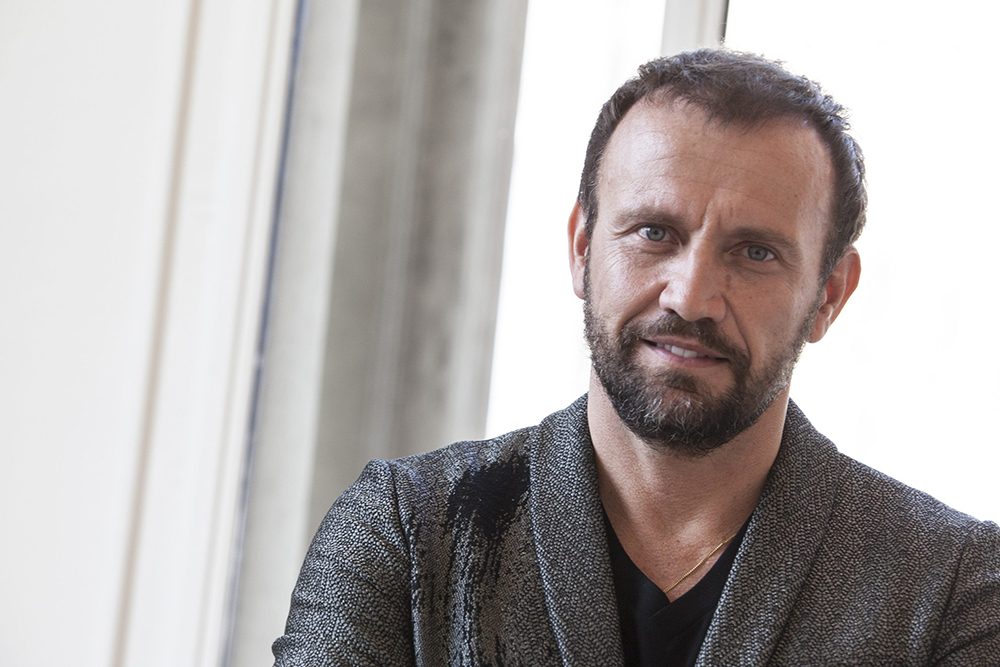
當馬若·波西尼(Mauro Porcini )最初知道他有機會從 3M 跳槽,成為百事公司(PepsiCo)歷史上第一位首席設計官時,,他拒絕了這個邀請,。然而當他與百事公司當時的首席執(zhí)行官英德拉·努伊在法國城市格勒諾布爾(Grenoble)會面后,他重新考慮了這個決定,。
“她試圖重塑整個行業(yè),,完全重塑人們與食品飲料世界互動的方式,” 波西尼本周三在中國澳門舉行的《財富》頭腦風暴設計大會的視頻對話中這樣說,。
波西尼說,,他加入百事公司后,馬上就面臨了一場“火的洗禮"——公司試圖應對可口可樂當時新推出的自動汽水機,。2009年,,百事的老對手可口可樂推出了名為“自由式”(Freestyle)的飲料機,用戶可以從100 多種不同的飲料里作出自己的選擇,。根據(jù)顧客的選擇,,這項被稱為 “微劑量”(microdosing)的新技術能從預裝盒里噴出精確數(shù)量的濃縮香精。
波西尼說,,百事想要參與競爭,,“試圖在這個賽場上擊敗(可口可樂)”,。在“沒有官方預算”的情況下,,他開始與客戶交談,卻發(fā)現(xiàn)花哨的新技術并不是用戶想要的,。
“首先,,客戶對價格非常敏感。他們不想花那么多錢買這種機器,,”他說,。另外,這些機器很大,,很多客戶“沒有足夠空間擺放它”,。
他說:“我們意識到可以嘗試一些不同的技術......并[利用]節(jié)省下來的部分成本,添加客戶真正需要的新功能,?!?/p>

百事公司于 2014 年推出了名為“螺旋塔”(Spire)觸摸屏汽水機。與可口可樂的“自由式”不同,,“螺旋塔”使用傳統(tǒng)的箱體內嵌袋系統(tǒng)來分配汽水,,價格則低于可口可樂的預裝盒?!奥菪斌w積更小,,成功地為百事公司贏得了新客戶。
他說,,他把同樣的方法帶到了百事可樂的logo設計中,。
在他加入時,百事可樂剛剛推出了一個新的(有爭議的)logo,,許多裝瓶商拒絕了這個新設計,。“他們認為這個設計不好,,缺乏活力,,”波西尼說。
但設計師知道他不能從頭再來,?!靶耹ogo剛剛推出,”他回憶道,,“我不能馬上改變它,!”他對字體和顏色進行了小幅調整,終于讓調整后的logo在 2013 年得到了所有裝瓶商的認可,。
時隔多年后,,波西尼再次為百事公司設計出一個新logo,它更具復古風格,,在今年早些時候首次對外亮相,。
設計的競爭優(yōu)勢
波西尼本周三還表示,一個好的設計能為企業(yè)帶來競爭優(yōu)勢,。
這位設計師認為,,企業(yè)領導者在過去可以用“其他辦法來保護設計師提供的平庸產(chǎn)品”,,使企業(yè)并不會受到平庸設計的影響,。
但在一個更加全球化和數(shù)字化的世界里,這種做法行不通了,。他說:“傳統(tǒng)的商業(yè)壁壘[正在]崩潰,。要么你為人們創(chuàng)造出非凡的東西,要么別人會取代你把它做出來,?!?/p>
他最后強調:“你的最佳競爭優(yōu)勢就是以人為本,為人們創(chuàng)造價值。這是設計工作的核心,?!保ㄘ敻恢形木W(wǎng))
譯者:珠珠
當馬若·波西尼(Mauro Porcini )最初知道他有機會從 3M 跳槽,成為百事公司(PepsiCo)歷史上第一位首席設計官時,,他拒絕了這個邀請,。然而當他與百事公司當時的首席執(zhí)行官英德拉·努伊在法國城市格勒諾布爾(Grenoble)會面后,他重新考慮了這個決定,。
“她試圖重塑整個行業(yè),,完全重塑人們與食品飲料世界互動的方式,” 波西尼本周三在中國澳門舉行的《財富》頭腦風暴設計大會的視頻對話中這樣說,。
波西尼說,,他加入百事公司后,馬上就面臨了一場“火的洗禮"——公司試圖應對可口可樂當時新推出的自動汽水機,。2009年,,百事的老對手可口可樂推出了名為“自由式”(Freestyle)的飲料機,用戶可以從100 多種不同的飲料里作出自己的選擇,。根據(jù)顧客的選擇,,這項被稱為 “微劑量”(microdosing)的新技術能從預裝盒里噴出精確數(shù)量的濃縮香精。
波西尼說,,百事想要參與競爭,,“試圖在這個賽場上擊敗(可口可樂)”,。在“沒有官方預算”的情況下,,他開始與客戶交談,卻發(fā)現(xiàn)花哨的新技術并不是用戶想要的,。
“首先,,客戶對價格非常敏感。他們不想花那么多錢買這種機器,,”他說,。另外,這些機器很大,,很多客戶“沒有足夠空間擺放它”,。
他說:“我們意識到可以嘗試一些不同的技術......并[利用]節(jié)省下來的部分成本,添加客戶真正需要的新功能,?!?/p>
百事公司于 2014 年推出了名為“螺旋塔”(Spire)觸摸屏汽水機。與可口可樂的“自由式”不同,,“螺旋塔”使用傳統(tǒng)的箱體內嵌袋系統(tǒng)來分配汽水,,價格則低于可口可樂的預裝盒,。“螺旋塔”體積更小,,成功地為百事公司贏得了新客戶,。
他說,他把同樣的方法帶到了百事可樂的logo設計中,。
在他加入時,,百事可樂剛剛推出了一個新的(有爭議的)logo,許多裝瓶商拒絕了這個新設計,?!八麄冋J為這個設計不好,缺乏活力,,”波西尼說,。
但設計師知道他不能從頭再來?!靶耹ogo剛剛推出,,”他回憶道,“我不能馬上改變它,!”他對字體和顏色進行了小幅調整,,終于讓調整后的logo在 2013 年得到了所有裝瓶商的認可。
時隔多年后,,波西尼再次為百事公司設計出一個新logo,,它更具復古風格,在今年早些時候首次對外亮相,。
設計的競爭優(yōu)勢
波西尼本周三還表示,,一個好的設計能為企業(yè)帶來競爭優(yōu)勢。
這位設計師認為,,企業(yè)領導者在過去可以用“其他辦法來保護設計師提供的平庸產(chǎn)品”,,使企業(yè)并不會受到平庸設計的影響。
但在一個更加全球化和數(shù)字化的世界里,,這種做法行不通了,。他說:“傳統(tǒng)的商業(yè)壁壘[正在]崩潰。要么你為人們創(chuàng)造出非凡的東西,,要么別人會取代你把它做出來,。”
他最后強調:“你的最佳競爭優(yōu)勢就是以人為本,,為人們創(chuàng)造價值,。這是設計工作的核心,?!保ㄘ敻恢形木W(wǎng))
譯者:珠珠
When Mauro Porcini was offered the chance to jump ship from 3M and become PepsiCo’s first-ever chief design officer, he initially turned it down. It took a meeting with then-CEO Indra Nooyi in the French city of Grenoble to get him to reconsider.
“She was trying to reshape an entire industry, an entire way of interacting with the world of food and beverage,” Porcini said Wednesday in a video conversation at Fortune‘s Brainstorm Design conference in Macau, China.
Immediately after joining PepsiCo, Porcini said he faced a “baptism of fire” in the company’s attempt to respond to Coca-Cola’s then-novel soda dispensing machine. PepsiCo’s archrival launched its Freestyle dispenser in 2009, which allowed users to choose from over 100 different drinks on demand. The technology, called microdosing, used cartridges to spurt out a precise amount of flavored concentrate to match to a customer’s choice.
Porcini said he felt Pepsi wanted to compete and “try to beat [Coca-Cola] at the same game.” Instead, with “no official budget,” he started talking to customers and found that the fancy new technology didn’t meet what users wanted.
“Customers, first of all, were very price-sensitive. They didn’t want to spend so much money for those kinds of machines,” he said. Plus, the machines were big, so many customers didn’t “have the space.”
“We realized that eventually there was an opportunity to use a different technology…and [use] some of the cost savings in adding additional features that were really relevant to the customer,” he said.
PepsiCo launched its touchscreen dispenser Spire in 2014. Unlike Coca-Cola’s Freestyle, the Spire used the traditional bag-in-box system to dispense soda, which was cheaper than the cartridges in Coca-Cola’s technology. The Spire’s smaller footprint succeeded in winning new customers for PepsiCo.
On Wednesday, Porcini said he brought that same approach to Pepsi’s logo. The company, at the time, had just debuted a new (and controversial) logo, but many bottlers rejected the new design. “They didn’t think it was the right one, didn’t have the right energy,” Porcini said.
But the designer knew he couldn’t just start again from scratch. “We just launched the new logo,” he remembered. “I couldn’t change it right away!” Instead, he resorted to small tweaks to the font and the color, and got all bottlers on board by 2013. Porcini was eventually able to design a new, more retro-style logo for Pepsi, which the company debuted earlier this year.
Design’s competitive advantage
On Wednesday, Porcini argued that design now offers companies a competitive advantage.
Companies could get away with a shoddy product in the past, the designer argued, as business leaders could use “other levers to protect…the mediocrity of your offering.”
But that doesn’t fly in a more globalized and digital world. “The traditional barriers to entry of business… [are] crumbling down,” he said. “Either you create something extraordinary for people, or somebody else will do it on your behalf,” he said.
“Your best competitive advantage is human-centricity, creating value for people. And design is all about this,” he concluded.






